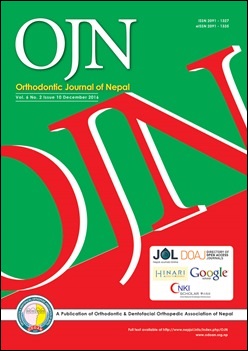Peak Level of Pain while uprighting Molars with Tri-helical Uprighting Spring
DOI:
https://doi.org/10.3126/ojn.v6i2.17414Keywords:
molar uprighting, peak pain, tri-helical uprighting springAbstract
Introduction: Orthodontic treatment has clear positive effects on a patient’s physiological, functional, esthetic, psychological, and social health. However the most common and problematic sequel of orthodontic treatment is pain and discomfort.
Objectives: To find out exact time of peak level of pain while uprighting molars for a week time with loop uprighting mechanics and weather the pain was associated with intake of pain medication.
Materials & Method: A cross-sectional analytical study was performed on finally selected thirty orthodontic patients with uprighting molars with age range of 10-40 years from of the Department of Orthodontics, University of the East, Philippines. Digitest Electricpulp tester was used to calibrate subjects with similar pain threshold level. An optimal molar uprighting force of 100 grams was employed with a customized tri-helical molar uprighting springs made with 0.016X0.022” stainless steel archwire. Measurement was done using tension gauge. Simultaneously 12 thermometer pain scale and 6 questionnaires forms were given to the subjects which were to be completed within 7 days based on their pain perception. The data were analyzed with Wilcoxon rank sum test, Chi-square test.
Result: Maximum pain was felt on day-1 during evening at 9:40 pm, which was strongly associated with intake of pain medication on day-1 with gradual decrease over a period of week.
Conclusion: There is a great need of precautionary measures like pain medication to avoid disturbance from daily activities of patients undergoing orthodontic treatment.
Downloads
Downloads
Published
How to Cite
Issue
Section
License
Copyright © held by Orthodontic & Dentofacial Orthopedic Association of Nepal
- Copyright on any research article is transferred in full to the Orthodontic & Dentofacial Orthopedic Association of Nepal upon publication in the journal. The copyright transfer includes the right to reproduce and distribute the article in any form of reproduction (printing, electronic media or any other form).
- Articles in the Orthodontic Journal of Nepal are Open Access articles published under the Creative Commons CC BY License (https://creativecommons.org/licenses/by/4.0/)
- This license permits use, distribution and reproduction in any medium, provided the original work is properly cited.




